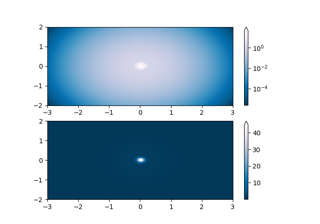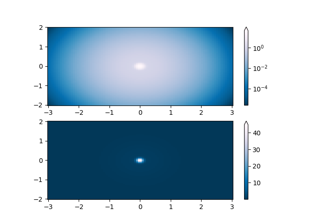matplotlib.colors.PowerNorm¶
-
class
matplotlib.colors.PowerNorm(gamma, vmin=None, vmax=None, clip=False)[source]¶ Bases:
matplotlib.colors.NormalizeLinearly map a given value to the 0-1 range and then apply a power-law normalization over that range.
Parameters: - vmin, vmaxfloat or None
If vmin and/or vmax is not given, they are initialized from the minimum and maximum value, respectively, of the first input processed; i.e.,
__call__(A)callsautoscale_None(A).- clipbool, default: False
If
Truevalues falling outside the range[vmin, vmax], are mapped to 0 or 1, whichever is closer, and masked values are set to 1. IfFalsemasked values remain masked.Clipping silently defeats the purpose of setting the over, under, and masked colors in a colormap, so it is likely to lead to surprises; therefore the default is
clip=False.
Notes
Returns 0 if
vmin == vmax.-
__call__(self, value, clip=None)[source]¶ Normalize value data in the
[vmin, vmax]interval into the[0.0, 1.0]interval and return it.Parameters: - value
Data to normalize.
- clipbool
If
None, defaults toself.clip(which defaults toFalse).
Notes
If not already initialized,
self.vminandself.vmaxare initialized usingself.autoscale_None(value).
-
__init__(self, gamma, vmin=None, vmax=None, clip=False)[source]¶ Parameters: - vmin, vmaxfloat or None
If vmin and/or vmax is not given, they are initialized from the minimum and maximum value, respectively, of the first input processed; i.e.,
__call__(A)callsautoscale_None(A).- clipbool, default: False
If
Truevalues falling outside the range[vmin, vmax], are mapped to 0 or 1, whichever is closer, and masked values are set to 1. IfFalsemasked values remain masked.Clipping silently defeats the purpose of setting the over, under, and masked colors in a colormap, so it is likely to lead to surprises; therefore the default is
clip=False.
Notes
Returns 0 if
vmin == vmax.
-
__module__= 'matplotlib.colors'¶
-
__slotnames__= []¶



